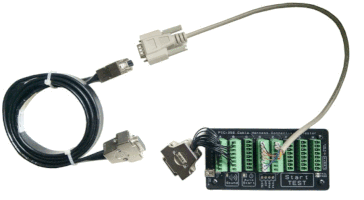This is a general cable wire size guide to help you choose the correct wire size for your electrical project.
Choosing a thicker wire provides higher current carrying capacity. It is safer to use thicker wire to conduct the current, but thicker wire is going to cost more. This guides provides you a gauge to select the most appropriate cable size.
The variety of cable brands varies in quality. The cable current conducting material and the insulation jacket material do have an impact of the amount of ampere current that a wire can conduct. The cable length and temperature of the conducting environment also plays a part. A good conducting material has lower resistance or better conductivity, produce less heat, therefore can carry more current. A good insulation jacket that can endure higher heat can handle more current before the jacket gets melted and fails.
*** Important Notes: The following wire size and current is only an estimate for a quick reference guide when selecting your cable size. It is important to check on the datasheet of the cable directly from the manufacturer. It is recommended to provide more buffer to the current capacity for your application.
Wire Size and Current Rating Table Guide
This wire size and current rating table provides a quick lookup table for your cable selection.
It is recommended to use a wire capacity that is 2 times of what your application is expecting to use.
If you want a more detailed computation, check out the next section for the calculation.
| Projected Maximum Operating Current | Wire Size (AWG) | Copper Wire Diameter Ø | Cross-sectional Area | Current Capacity (estimated) |
|---|---|---|---|---|
| 0.1A | ||||
| 0.3A | ||||
| 0.5A | 30AWG Wire Wrapping wire | 0.3mm | 0.05mm2 | 0.8A |
| 1A | 28AWG | 0.36mm | 0.08mm2 | 1.25A |
| 2A | 27AWG | |||
| 3A | 26AWG | 0.46mm | 0.14mm2 | 3.5A |
| 5A | 24AWG CAT5e Network Cable | 0.61mm | 0.2mm2 | 5A |
| 22AWG | 0.78mm | 0.33mm2 | 8.73A | |
| 10A | 21AWG | |||
| 20AWG | 0.92mm | 0.5mm2 | 13.87A | |
| 25A | 17AWG | 1.34mm | 1.06mm2 | 29.2A |
| 16AWG | 1.31mm2 (closest 1.5mm2) | |||
| 50A | 14AWG Electrical Wire | 1.78mm | 2.07mm2 (closest 2.5mm2) | 55.6A |
| 12AWG Electrical Wire | about 4mm2 | |||
| 10AWG Electrical Wire | about 6mm2 |
Calculate current capacity and voltage drop
For application that cannot afford for thicker wire with higher current capacity, it is important to calculate close to your projected situation. We will need to know the amount of current the wire can carry, as well as the expected drop in voltage over the wire distance (to and from).
Wire conducting material and their resistivity.
| Wire Material | Resistivity per metre | |
| Copper | 0.0174 μΩ.m | 1.724 x 10-8 Ω.m |
| Aluminum | 0.0265 μΩ.m | 2.65 x 10-8 Ω.m |
| Silver | 0.0265 μΩ.m | 2.65 x 10-8 Ω.m |
| Carbon | 0.1 μΩ.m | 10 x 10-8 Ω.m |
| Iron | 0.1 μΩ.m | 10 x 10-8 Ω.m |
The formula to compute the resistance of a particular wire material is base on normal room temperature of 20 °C.
Resistance, R = ρ L / A Ω
where
R = resistance of the conductor (ohms, Ω)
ρ = resistivity of the conductor material (ohm metre, Ω m)
L = length of conductor (m)
A = cross-sectional area of conductor (m2)

